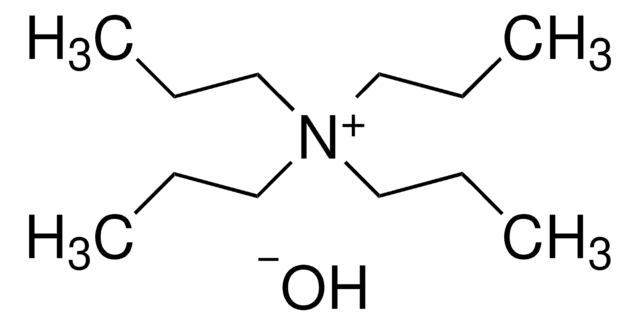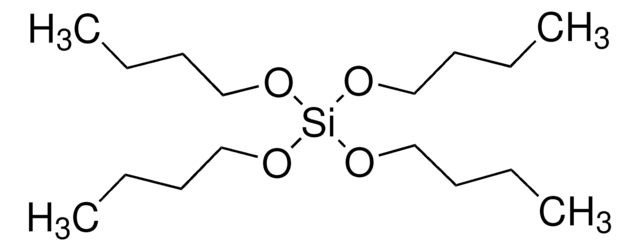131903
Orthosilicate de tétraéthyle
reagent grade, 98%
Synonyme(s) :
Ester tétraéthylique de l'acide orthosilicique, TEOS, Tétraéthoxysilane
About This Item
Produits recommandés
Qualité
reagent grade
Niveau de qualité
Densité de vapeur
7.2 (vs air)
Pression de vapeur
<1 mmHg ( 20 °C)
Pureté
98%
Forme
liquid
Indice de réfraction
n20/D 1.382 (lit.)
Point d'ébullition
168 °C (lit.)
Densité
0.933 g/mL at 20 °C (lit.)
Chaîne SMILES
CCO[Si](OCC)(OCC)OCC
InChI
1S/C8H20O4Si/c1-5-9-13(10-6-2,11-7-3)12-8-4/h5-8H2,1-4H3
Clé InChI
BOTDANWDWHJENH-UHFFFAOYSA-N
Vous recherchez des produits similaires ? Visite Guide de comparaison des produits
Description générale
Application
- As an anti-solvent to fabricate efficient perovskite layer for inverted planar solar cells with enhanced power conversion efficiency and reproducibility. TEOS helps to achieve high-quality perovskite films with reduced density of defects, and thus slower carrier recombination.
- As a sol-gel precursor to synthesize SiO2-TiO2 anti-reflective self-cleaning coatings for solar cells.
- To fabricate nano silica functionalized crosslinked hybrid membranes for proton exchange membrane fuel cell applications. These membranes have better proton conductivity and thermal stability.
- To prepare poly(vinylidene fluoride)/TEOS matrix separator to enhance the performance of Li-ion batteries. The separator exhibits excellent electrolyte retention and wettability.
Caractéristiques et avantages
- Excellent adhesion on substrates
- Uniform film deposition
- Cross-linker to introduce polymer strands into hydrogel
Mention d'avertissement
Warning
Mentions de danger
Conseils de prudence
Classification des risques
Acute Tox. 4 Inhalation - Eye Irrit. 2 - Flam. Liq. 3 - STOT SE 3
Organes cibles
Respiratory system
Code de la classe de stockage
3 - Flammable liquids
Classe de danger pour l'eau (WGK)
WGK 1
Point d'éclair (°F)
113.0 °F - closed cup
Point d'éclair (°C)
45 °C - closed cup
Équipement de protection individuelle
Eyeshields, Faceshields, Gloves, type ABEK (EN14387) respirator filter
Faites votre choix parmi les versions les plus récentes :
Déjà en possession de ce produit ?
Retrouvez la documentation relative aux produits que vous avez récemment achetés dans la Bibliothèque de documents.
Les clients ont également consulté
Articles
Silica is a very popular inorganic nanomaterial used in a wide range of applications including fillers for rubber, catalyst supports, separation media, carriers in food and agriculture, and abrasive/anticaking agents in cosmetics. It is also widely believed to be an important material for biomedical applications for following reasons.
Magnetism and magnetic materials have been of scientific interest for over 1,000 years. More recently, fundamental investigations have focused on exploring the various types of magnetic materials and understanding the magnetic effects created by electric currents.
Synthesis of Melting Gels Using Mono-Substituted and Di-Substituted Alkoxysiloxanes
The properties of many devices are limited by the intrinsic properties of the materials that compose them.
Notre équipe de scientifiques dispose d'une expérience dans tous les secteurs de la recherche, notamment en sciences de la vie, science des matériaux, synthèse chimique, chromatographie, analyse et dans de nombreux autres domaines..
Contacter notre Service technique












